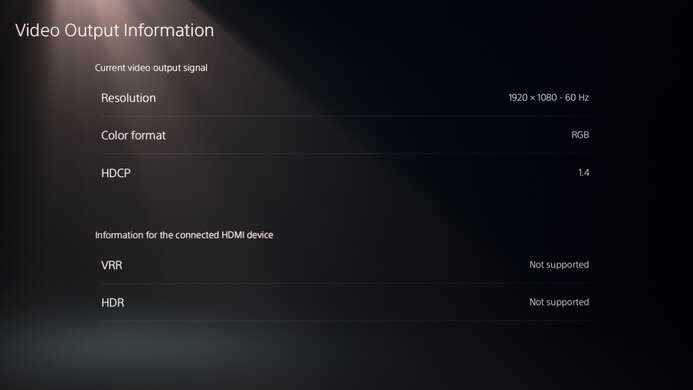The ASUS VG246H is a pretty basic 24 inch monitor with a 1080p resolution. Marketed mainly as a gaming monitor, it has outstanding low input lag for a responsive gaming experience. It supports FreeSync variable refresh rate (VRR) technology, which can reduce screen tearing. It has decent peak brightness and very good reflection handling, so glare shouldn't be an issue for most people, and the unit we tested has outstanding gray uniformity. Unfortunately, this monitor doesn't have much connectivity, though, with no USB ports, no DisplayPort, and only a single HDMI port.
Our Verdict
The ASUS VG246H is an okay monitor for most uses. Primarily marketed as a gaming monitor, the low input lag and FreeSync support make it not a bad choice for gaming, but the 24-inch, 1080p screen isn't very immersive and has slow response times. Similarly, the relatively low amount of screen real estate might be limiting for office use, but the stand has outstanding ergonomics, and the image remains accurate at an angle. It's an alright choice for multimedia and media creation, but the low contrast and bad black uniformity make it a poor choice for a dark room.
- Outstanding ergonomics.
- Image remains accurate at an angle.
- Good reflection handling.
- Small screen size and low resolution aren't ideal for multitasking.
- Blacks look gray in a dark room.
- Doesn't get bright enough to fight intense glare.
Overall, the ASUS VG246H is a good office monitor, but it might not be ideal for everyone. The stand has outstanding ergonomics, and the image remains accurate at an angle, so it's easy to find an ideal viewing position. It has very good reflection handling and decent peak brightness, so glare shouldn't be an issue in most bright offices. On the other hand, the relatively small, low-resolution screen isn't great for multitasking.
- Outstanding ergonomics.
- Image remains accurate at an angle.
- Good reflection handling.
- Small screen size and low resolution aren't ideal for multitasking.
- Doesn't get bright enough to fight intense glare.
The ASUS VG246H isn't bad as a gaming monitor. It has low input lag for a responsive gaming experience and supports FreeSync variable refresh rate technology for nearly tear-free gaming, which is great. Unfortunately, it has slow response times that lead to motion blur with fast-moving objects. Also, the relatively small screen doesn't deliver a very immersive gaming experience.
- FreeSync variable refresh rate support.
- Low input lag.
- Blacks look gray in a dark room.
- Limited to 75Hz refresh rate.
- Slow response times.
The ASUS VG246H is alright for multimedia. It has very good reflection handling and decent peak brightness, so glare shouldn't be a concern during the day. The image remains accurate at an angle, so it's great for sharing the screen with someone else. Unfortunately, it doesn't look good in dark rooms as it has a low contrast ratio that makes blacks look gray in the dark.
- Outstanding ergonomics.
- Image remains accurate at an angle.
- Blacks look gray in a dark room.
- Doesn't support HDR.
The ASUS VG246H is a decent monitor for media creation. It has outstanding ergonomics and wide viewing angles, great for sharing the screen with a client or coworker, and the unit we tested has excellent gray uniformity. On the other hand, the relatively small size and low-resolution screen aren't ideal for working with larger or more detailed projects.
- Outstanding ergonomics.
- Image remains accurate at an angle.
- Good reflection handling.
- Small screen size and low resolution aren't ideal for multitasking.
- Blacks look gray in a dark room.
- Doesn't support HDR.
The ASUS VG246H doesn't support HDR.
Changelog
- Updated Aug 29, 2024: Added that the AOC 24G15N has a higher Refresh Rate.
- Updated Aug 15, 2024: Added that the Dell P2425H has a USB hub.
- Updated May 29, 2024: Added that the Dell P2423D has better Text Clarity.
- Updated Feb 14, 2023: Added text in the macOS Compatibility and Console Compatibility boxes and clarified text throughout as part of Test Bench 1.2.
Check Price
Differences Between Sizes And Variants
We tested the 24 inch ASUS VG246H, which is the only size available. This monitor appears to be a newer version of the ASUS VG245H.
| Model | Size | Native Resolution | Max Refresh rate | Panel Type | Notes |
|---|---|---|---|---|---|
| VG245H | 24" | 1080p | 75Hz | TN | FreeSync support |
| VG246H | 24" | 1080p | 75Hz | IPS | FreeSync support |
If you come across a different type of panel or your ASUS VG246H doesn't correspond to our review, let us know, and we'll update the review. Note that some tests, like gray uniformity, may vary between individual units.
Our unit was manufactured in February 2021; you can see the label here.
Popular Monitor Comparisons
The ASUS VG246H is a very basic 24 inch budget gaming monitor. It's not the best at anything but delivers decent all-around performance for most uses.
For more options, check out our recommendations for the best 24-25 inch monitors, the best budget gaming monitors, and the best 1080p monitors.
The ASUS VG246H is much better than the BenQ ZOWIE XL2411P. The ASUS has much better viewing angles and ergonomics, and the unit we tested has better gray uniformity. For gamers, the BenQ has a better response time at its max refresh rate, but it doesn't support variable refresh rate technology (VRR). Which one is better for gaming will depend on personal preference. If motion blur bothers you more, the BenQ is a slightly better choice. If screen tearing bothers you more, the ASUS is a slightly better choice.
The ASUS VG246H and the ViewSonic XG2402 use different panel technologies, each with strengths and weaknesses. The ASUS has much better viewing angles and better ergonomics, and the unit we tested has better gray uniformity. On the other hand, if ergonomics or viewing angles don't matter to you, the ViewSonic is much better for gaming, as it has significantly better motion handling, with less blur behind fast-moving objects, and it has less input lag.
The newer ASUS VG246H is better than its predecessor, the ASUS VG245H. The new model uses an IPS-type panel instead of a TN-type panel, so it has much better viewing angles. This new model also has much better gray uniformity and significantly improved color volume. Although this difference is minor, the newer model defaults to a 75Hz refresh rate, while the older model defaults to a 60Hz refresh rate but can overclock to 75Hz.
The Acer Nitro XF243Y Pbmiiprx is much better than the ASUS VG246H. The Acer has a higher refresh rate and much faster response times, resulting in significantly clearer motion, with almost no noticeable blur behind fast-moving objects. The Acer also supports HDR, although this doesn't add much, and it has better viewing angles.

We buy and test more than 30 monitors each year, with units that we buy completely on our own, without any cherry-picked units or samples. We put a lot into each unbiased, straight-to-the-point review, and there's a whole process from purchasing to publishing, involving multiple teams and people. We do more than just use the monitor for a week; we use specialized and custom tools to measure various aspects with objective data-based results. We also consider multiple factors before making any recommendations, including the monitor's cost, its performance against the competition, and whether or not it's easy to find.
Test Results

The ASUS VG246H looks nearly identical to most ASUS gaming monitors, including its predecessor, the ASUS VG245H.
The ASUS VG246H has decent overall build quality. It's entirely plastic, but there's very little flex. There's very little wobble when adjusting the stand, and motion feels smooth. After testing, we noticed that the bottom bezel is no longer perfectly flush with the screen and bubbles out slightly. Unfortunately, this is a common issue, and we've seen similar issues on many other monitors.
This monitor has outstanding ergonomics, so you won't have any issues adjusting it to an ideal viewing position. It also makes it a great choice for a multimonitor setup. Unfortunately, there's no cable management in the stand, so it can be a bit tricky to keep the back of the monitor neat.
The ASUS VG246H doesn't have a local dimming feature. The video is for reference only, so you can see how the local dimming feature on other displays compares to one without local dimming.
This monitor has decent peak brightness in SDR. It's bright enough for most rooms, but it might not be bright enough to overcome glare in a bright room.
These measurements were taken after calibration, in the 'Racing Mode' Picture Mode, but with the backlight at max. The peak brightness can change depending on which mode you're using.
The ASUS VG246H doesn't support HDR.
The horizontal viewing angles on this monitor are good. If you're too far to the left or right, reds shift and lose accuracy, the brightness decreases, and the image starts to appear washed out.
The vertical viewing angles on this monitor are just okay, but most people won't notice any issues. The image looks dimmer and washed out if you're too far above or below the screen, but as long as you adjust the stand properly, it shouldn't cause any issues.
The ASUS VG246H has great accuracy before calibration. Most colors and the white balance are only slightly off, and the color temperature is close to the 6500K target. However, gamma doesn't follow the target sRGB curve, resulting in all scenes becoming brighter than they should be. Unfortunately, the sRGB mode on this monitor disables most picture settings, including the Brightness, so if you want to use those settings, you'll need to use a less accurate mode.
This monitor has fantastic accuracy after calibration. Any remaining inaccuracies in colors or shades of gray aren't noticeable to the naked eye, and gamma tracks the sRGB target curve almost perfectly.
This monitor has an excellent SDR color gamut. It can display all of the sRGB color space used by most web and desktop content. It also has decent coverage of the wider Adobe RGB color space, but it might not be good enough for professional photo/video use.
This monitor has excellent color volume. Due to the low contrast ratio, it can't display darker saturated colors very well, and like most LCDs on the market, blues aren't quite as bright as other colors or pure white.
The ASUS VG246H doesn't support HDR.
The ASUS VG246H doesn't support HDR.
This monitor has decent text clarity, but we strongly recommend running the Windows ClearType (top photo) wizard if you're on a PC. There are some font issues in apps that don't support ClearType or if it's disabled. This is especially noticeable in diagonal lines, like on the R and G in the above photos. If you want a monitor with better text clarity, check out the Dell P2423D.
The ASUS VG246H has a native refresh rate of 75Hz. This slightly differs from the previous model, the ASUS VG245H, which defaulted to a 60Hz refresh rate but can be overclocked to 75Hz. If you want a monitor with an even higher refresh rate, check out the AOC 24G15N.
This monitor supports FreeSync variable refresh rate technology (VRR), which can reduce screen tearing, but it doesn't support G-SYNC.
| Overdrive Setting | Response Time Chart | Response Time Tables | Motion Blur Photo |
| 0 | Chart | Table | Photo |
| 20 | Chart | Table | Photo |
| 40 | Chart | Table | Photo |
| 60 | Chart | Table | Photo |
| 80 | Chart | Table | Photo |
| 100 | Chart | Table | Photo |
The ASUS VG246H has an okay response time at its max refresh rate of 75Hz, but there's noticeable blur with most fast-moving objects. The recommended overdrive setting is '60' because it has a quicker response time than the lower settings, and it has less overshoot than the higher settings.
The ASUS VG246H doesn't support a 120Hz signal.
| Overdrive Setting | Response Time Chart | Response Time Tables | Motion Blur Photo |
| 0 | Chart | Table | Photo |
| 20 | Chart | Table | Photo |
| 40 | Chart | Table | Photo |
| 60 | Chart | Table | Photo |
| 80 | Chart | Table | Photo |
| 100 | Chart | Table | Photo |
The response time at 60Hz is disappointing. It's similar to its max refresh rate but with just a bit more overshoot. Once again, the recommended overdrive setting is '60' as '80' and '100' have too much overshoot.
The ASUS VG246H has an optional backlight strobing feature that can improve the appearance of motion by reducing how long each frame is held on the screen. Sadly, the backlight flicker causes noticeable duplications in motion.
This monitor has excellent low input lag, which is very important for a responsive gaming experience.
The relatively low resolution of this display, combined with the small size, isn't ideal for multitasking or desktop use. If you want something bigger, then check out the LG 27MN60T-W.
If you're looking for a monitor with a USB hub, check out the Dell P2425H.
The ASUS VG246H works well with macOS, but you can't use the VRR feature. There's a bit of flickering while using the OS' settings page, but the flicker stops when using other applications like Google Chrome, Safari, or in games. Despite the lack of HDR support, colors look good too. If you're using a MacBook, some windows return to their original position when waking the laptop up from sleep or opening the lid, but not all of them go back.















































